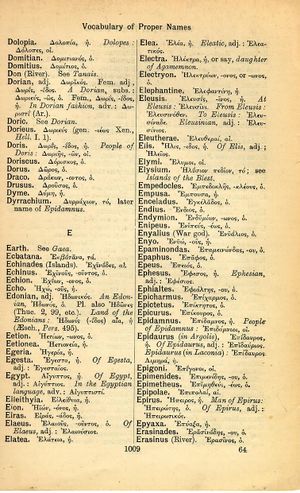Egeria
πάλαι ποτ' ἦσαν ἄλκιμοι Μιλήσιοι → the Milesians were mighty once
English > Greek (Woodhouse)
Ἠγερία, ἡ.
Latin > English (Lewis & Short)
Ēgĕrĭa: (Aeg-), ae, f., = Ἠγερία,
I a nymph or Camoena celebrated in Roman mythology, the wife and instructress of Numa, with two sacred groves and fountains, the one near Rome, opposite the Porta Capena, the other in the neighborhood of Aricia, Liv. 1, 19; 21; Val. Max. 1, 2, 1; Ov. F. 3, 154; 261 sq.; 4, 669; id. M. 15, 482 sq.; Verg. A. 7, 763; 775; Juv. 3, 12 sq.
Latin > French (Gaffiot 2016)
Ēgĕrĭa,¹³ æ, f., Égérie nymphe que Numa feignait de consulter] : Liv. 1, 19, 5 ; Virg. En. 7, 763.
Latin > German (Georges)
Ēgeria, ae, f., eine italische weissagende Quellnymphe od. Kamene, nach der röm. Mythe Gemahlin des Numa u. dessen Beraterin in Religionseinrichtungen, deren Quelle u. Hain die Sage teils in ein Tal bei Aricia (Aricina vallis, Ov. met. 15, 488; vgl. Verg. Aen. 7, 763 sq.), teils in das bei Rom vor dem kapenischen Tor gelegene Tal (j. Cafarella gen.) verlegte (Iuven. 3, 10 sqq.), Val. Max. 1, 2, 1. Liv. 1, 19 u. 21 (s. Schmid Hor. ep. 2, 1, 27). Wagner De Egeria fonte et specu eiusque situ. Marburg 1824.

